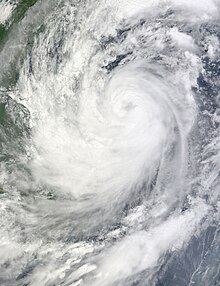 Ketsana prior to peak intensity on September 28 | |
| Meteorological history | |
|---|---|
| Formed | September 24, 2009 |
| Dissipated | September 30, 2009 |
| Typhoon | |
| 10-minute sustained (JMA) | |
| Highest winds | 130 km/h (80 mph) |
| Lowest pressure | 960 hPa (mbar); 28.35 inHg |
| Category 2-equivalent typhoon | |
| 1-minute sustained (SSHWS/JTWC) | |
| Highest winds | 165 km/h (105 mph) |
| Lowest pressure | 955 hPa (mbar); 28.20 inHg |
| Overall effects | |
| Fatalities | 665 direct |
| Missing | 439 |
| Damage | $1.15 billion (2009 USD) |
| Areas affected | Philippines, China, Vietnam, Laos, Cambodia, Thailand |
| IBTrACS | |
Part of the 2009 Pacific typhoon season | |
Typhoon Ketsana, known in the Philippines as Tropical Storm Ondoy, was the second-most devastating tropical cyclone of the 2009 Pacific typhoon season, causing $1.15 billion in damages and 665 fatalities, only behind Morakot earlier in the season, which caused 956 deaths and damages worth $6.2 billion. Ketsana was the sixteenth tropical storm, and the eighth typhoon of the season. It was the most devastating tropical cyclone to hit Manila,[1] surpassing Typhoon Patsy (Yoling) in 1970.
Ketsana formed early about 860 km (530 mi) to the northwest of Palau on September 23, 2009. The depression remained weak and was downgraded to a low pressure area later that day by the Japan Meteorological Agency (JMA) but after drifting through extremely favorable conditions, it intensified the next day and was categorized as Tropical Depression by the Philippine Atmospheric, Geophysical and Astronomical Services Administration (PAGASA) and was given the name Ondoy after entering the Philippine Area of Responsibility. The Joint Typhoon Warning Center (JTWC) issued a Tropical Cyclone Formation Alert on the depression. It was then upgraded to a tropical depression by the JMA later that morning before the JTWC followed suit early on September 25, designating the depression as 17W. Soon, Ketsana was upgraded to a tropical storm before passing over the Philippines. As it moved into the South China Sea the storm intensified while moving toward the west, and was categorized as a Severe Tropical Storm by the JMA.
President Gloria Macapagal Arroyo declared a "state of calamity" encompassing most of Luzon after at least 86 people were initially reported dead in landslides and other incidents.[2] Flood water levels reached a record 20 feet (6.1 m) in rural areas. As of October 24, 2013, at least 464 deaths in the Philippines were officially reported from the typhoon.[a]
- ^ "Metro Manila, 25 provinces placed under state of calamity". GMANews.TV. September 26, 2009. Archived from the original on September 29, 2009. Retrieved December 9, 2009.
- ^ "Philippines storm leaves 106 dead — report". Independent Online. September 28, 2009. Archived from the original on May 22, 2008. Retrieved September 27, 2009.
- ^ Cite error: The named reference
yahoowas invoked but never defined (see the help page). - ^ Cite error: The named reference
damagedwas invoked but never defined (see the help page). - ^ Weaver, Matthew (September 28, 2009). "Philippines storm death toll rises". The Guardian. London. Retrieved December 9, 2009.
- ^ "Philippines 'overwhelmed' as new storm threatens after Ketsana". The Times. London. September 28, 2009. Retrieved December 9, 2009.[dead link]
- ^ "Philippine flood death toll rises". London: The Daily Telegraph. September 28, 2009. Retrieved December 9, 2009.
- ^ Cite error: The named reference
Whywas invoked but never defined (see the help page). - ^ "Death toll from Ondoy rises to 337". ABS-CBN News. Agence France-Presse. October 9, 2009. Retrieved December 9, 2009.
Cite error: There are <ref group=lower-alpha> tags or {{efn}} templates on this page, but the references will not show without a {{reflist|group=lower-alpha}} template or {{notelist}} template (see the help page).